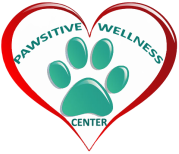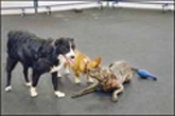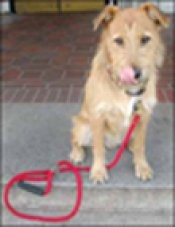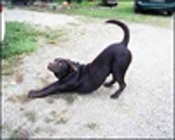|
Sitting/lying down/exposing underside: appeasing/deferent dog lowers body posture, exposing vulnerable parts Turning head away, averting eyes: appeasing/deferent dog avoids eye contact, exposes neck Avoidance Dog turns away; shuts down; evades handler’s touch and treats. Brow Ridges Furrows or muscle ridges in the dog’s forehead and around the eyes. Difficulty Learning Dogs are unable to learn well or easily when under significant stress. Digestive Disturbances Vomiting and diarrhea can be a sign of illness – or of stress; the digestive system reacts strongly to stress. Carsickness is often a stress reaction. Displacement Behaviors These are behaviors performed in an effort to resolve an internal stress conflict for the dog. They may be observed in a dog who is stressed and in isolation – for example a dog left alone in an exam room in a veterinary hospital – differentiating them from behaviors related to relationship. Blinking: Eyes blink at a faster-than normal rate Nose-Licking: Dog’s tongue flicks out once or multiple times Chattering teeth Scratching Shaking off (as if wet, but dog is dry) Yawning Drooling May be an indication of stress – or response to the presence of food, an indication of a mouth injury, or digestive distress. Excessive Grooming Dog may lick or chew paws, legs, flank, tail, and genital areas, even to the point of self-mutilation. Hyperactivity Frantic behavior, pacing, sometimes misinterpreted as ignoring, “fooling around,” or “blowing off” owner. Immune System Disorders Long-term stress weakens the immune system. Immune related problems can improve when overall levels of stress are reduced. Lack of Attention/Focus The brain has difficulty processing information when stressed. Leaning/Clinging The stressed dog seeks contact with human as reassurance. Lowered Body Posture “Slinking,” acting “guilty,” or “sneaky” (all misinterpretations of dog body language) can be indicators of stress. Mouthing Willingness to use mouth on human skin – can be puppy exploration or adult poor manners, but can also be an expression of stress, ranging from gentle nibbling (flea biting) to hard taking of treats, to painfully hard mouthing, snapping, or biting. Obsessive-Compulsive Disorders These include compulsive imaginary fly-snapping behavior, light- and shadow-chasing, tail-chasing, pica (eating nonfood objects), flank-sucking, self-mutilation, and more. While OCDs probably have a strong genetic component, the behavior itself is usually triggered by stress. Panting Rapid shallow or heavy breathing is normal if the dog is warm or has been exercising, otherwise can be stress-related. Stress may be external (environment) or internal (pain, other medical issues). Stretching
To relax stress-related tension in muscles. May also occur as a non-stress behavior after sleeping or staying in one place for extended period. Stiff Movement Tension can cause a noticeable stiffness in leg, body, and tail movements. Sweaty Paws Damp footprints can be seen on floors, exam tables, rubber mats. new blog posts on developing site www.pawsitivewellnesscenter.com
0 Comments
Your comment will be posted after it is approved.
Leave a Reply. |
Blog CreatorMary DeRoche Archives
April 2024
Categories
All
|
DISCLAIMER: I, Mary DeRoche, am not a veterinarian and do not practice medicine. I do not diagnose, cure, heal, treat disease or otherwise prescribe medication. I assist people in working with their animals in correcting energetic imbalances in their pet’s bio-field that assists the body to release its innate healing ability. When the energy chi of the body is balanced and moving correctly, the body’s innate natural energy heals itself. All healing is self-healing. Animals are affected by their environment so I also include the pet parents in my work. Animals do pick up energy from their family and environment. I only recommend the use of therapeutic grade essential oils for your pets because therapeutic grade essential oils have been tested to guarantee that they are free of synthetics, additives, toxins and any other impurities, which can result in side effects and/or inconsistent results. Essential oils and supplements are recommendations to help boost the pet’s immune system.
I recommend that clients continue to see their pet’s regular veterinarian and follow their advice and my work is a complement to regular allopathic medicine. My spiritual energy work is not a substitute for conventional medical diagnosis or treatment for any medical or psychological condition. For such issues, you should seek the proper licensed veterinarian. I am a Healing Touch for Animals Practitioner and a Subtle Energy Practitioner and my work is spiritually and energetically based and I believe all healing is spiritual in nature. I do not make any promises, warranties or guarantees about results of my work, or of the energy sessions. The energy sessions help many animals but like any energy work, it might not work for everyone. The use of essential oils, herbs and supplements is to assist the pet with balancing chakra centers for proper energy flow or chi.
© 2013~2023 Pawsitive Wellness Center All Rights Reserved.
I recommend that clients continue to see their pet’s regular veterinarian and follow their advice and my work is a complement to regular allopathic medicine. My spiritual energy work is not a substitute for conventional medical diagnosis or treatment for any medical or psychological condition. For such issues, you should seek the proper licensed veterinarian. I am a Healing Touch for Animals Practitioner and a Subtle Energy Practitioner and my work is spiritually and energetically based and I believe all healing is spiritual in nature. I do not make any promises, warranties or guarantees about results of my work, or of the energy sessions. The energy sessions help many animals but like any energy work, it might not work for everyone. The use of essential oils, herbs and supplements is to assist the pet with balancing chakra centers for proper energy flow or chi.
© 2013~2023 Pawsitive Wellness Center All Rights Reserved.




 RSS Feed
RSS Feed